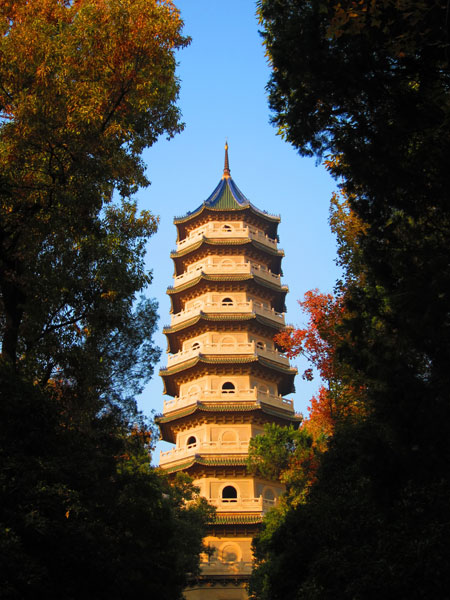
Wandering around the paths in Linggu Temple takes visitors to the Linggu Pagoda, which can be viewed through the trees as they approach. Photos by Hari Raj / For China Daily
China's former capital has a rich history. Hari Raj explores the city's abundance of museums, scenic beauty spots and local food.
The past and the present coexist amicably in Nanjing, China's former capital and the current seat of Jiangsu province capital. The city sits at the intersection of the Yangtze River and the rail route from Beijing, a position that helped it become a commercial and political hub - one that is well aware of its history. We arrive on late Friday, pop out of our hostel to admire the surroundings, and immediately get swept up in a horde of people. Surely this human deluge is either fleeing a fire or mobbing a celebrity? The answer is soon apparent. We are staying quite literally around the corner from Nanjing's famous Fuzimiao area.
Here, you will find the Song Dynasty (960-1279) Confucius temple that gives the area its name, playing stately host to the crowds. And then there is the Qinhuai River - pretty by day but gorgeous at night when the water comes alive with reflected neon.
There are glitzy shops andrestaurants that cater to tourists and alleys containing numerous stalls where you can buy everything from snacks to pets - preferably not at the same place.
I am delighted to discover that stinky tofu is a local specialty, my travel companion considerably less so.
The next morning, we rise early and head to the city walls, which are more than 600 years old. Nanjing's south gate is known as the "Gate of China", and the gate complex contains a small archery range where we establish the generation and gender gaps between English legend Robin Hood and The Hunger Game's Katniss Everdeen.
The walls rise to form an elevated plaza, a favorite meeting place for families with young children. Various games are played with various degrees of passion, and panoramic views of the city are garnished by brilliant blue skies and more than a few kites.
From here we trek north, detouring for a quick walk around the rather pretty Mochou Lake before heading west to the Memorial Hall of the Victims of the Nanjing Massacre.
In 1937, the Japanese army occupied Nanjing and began six weeks of destruction, pillage, rape and slaughter. At that time, more than 300,000 people were killed, and the memorial is a stark reminder of that loss.
The pyramidal structure looms over the surrounding buildings, as does the grief-contorted statue outside it. The exterior is minimalist. Small statues, commemorating the fallen and those who fled, keep watch beside a long, quiet pool.
Inside, the aesthetic is similar. There is a giant cross standing over paths that cut through gravel, leading to walls bearing the names of those who fell to Japanese cruelty. There are historical documents and films, but the simple, powerful emptiness stands as a silent tribute to the trauma the city endured.

Copyright ©1999-2011 Chinanews.com. All rights reserved.
Reproduction in whole or in part without permission is prohibited.